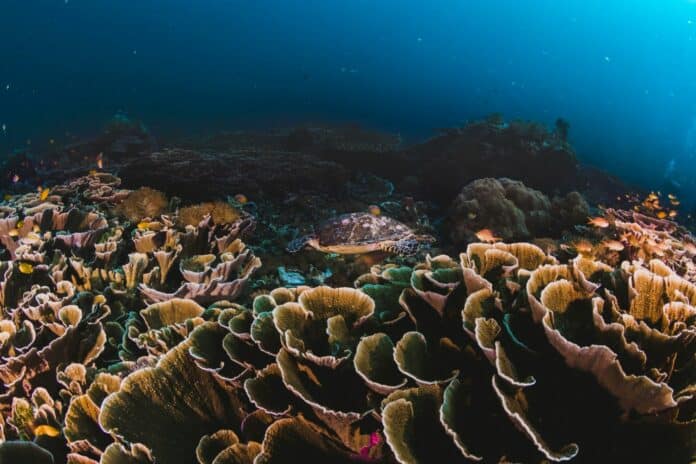Under heat stress, coral holobionts’ thermal bleaching percentage demonstrates interspecific variations that are intimately linked to the microbiome associated with corals. The ecological implications of community dynamics and interactions between Symbiodiniaceae and fungi regarding coral thermal bleaching sensitivity are still unknown.
A new study provides insights into the role of microbes and their interaction as drivers of interspecific differences in coral thermal bleaching.
Lead study author Biao Chen, Ph., an assistant professor with the Coral Reef Research Center of China, School of Marine Science at Guangxi University, said, “The diversity, community dynamic and interaction of coral-associated microorganisms play important roles in the health state and climate change response pattern of coral reefs. We urge the creation of more expansive coral reef microbial datasets on a global scale and recommend undertaking interdisciplinary research encompassing ecology, marine chemistry, physical oceanography, and microbiomics.”
The effects of global warming have caused significant biodiversity losses and coral thermal bleaching in coral reef ecosystems. Coral reefs, also known as coral holobionts, consist of animal hosts, endosymbiotic Symbiodiniaceae (a family of marine dinoflagellates), bacteria, archaea, fungi, and viruses.
During heatwave occurrences, corals have demonstrated considerable interspecific variability in the degree of bleaching and heat tolerance. The relationships between fungi and Symbiodiniaceae on variations in coral heat tolerance remain unknown, even though scientists are aware that the coral-associated microbiome is critical in controlling the environmental tolerance of coral reefs.
To fill this knowledge gap, scientists set out to study Huangyan Island, a reef in the South China Sea with a heightened risk of coral bleaching. This selection was deliberate due to the notably higher sea surface temperatures of the coral reefs surrounding Huangyan Island compared to the Xisha Islands at the same latitude.
The 18 coral species the researchers focused on are widely dispersed throughout the South China Sea’s tropical regions. Their study focused on determining the extent of bleaching during the notable coral bleaching event that took place there in 2020. A grading system for these 18 coral species’ susceptibility to heat bleaching was developed as a result of this investigation.
In the last phase of the study, scientists focused on the dynamic interactions that occur amongst coral organisms, notably looking at the communities of fungus and Symbiodiniaceae. They discovered possible relationships between the coral heat bleaching susceptibility ranking and ecological markers of the Symbiodiniaceae and fungal populations.
The study discovered that the dominant group in the coral microbial community on Huangyan Island was the heat-tolerant Symbiodiniaceae. An increase in pathogen abundance and fungal variety is closely correlated with an increase in coral’s sensitivity to thermal bleaching.
By building an interaction network between Symbiodiniaceae and fungus in corals, the researchers determined that limiting fungal parasitism and fostering robust interaction network resilience would aid coral heat acclimatization.
Chen said, “Our study highlights the ecological effects of microbiome dynamics and interactions between Symbiodiniaceae and fungi on coral thermal bleaching susceptibility, providing insights into the role of microorganisms and their interaction as drivers of interspecific differences in coral thermal bleaching.”
“The study is poised to establish a preliminary groundwork for delving into the response patterns of coral-associated microorganisms to global warming.”
Journal Reference:
- Biao Chen, Yuxin Wei et al. The microbiome dynamics and interaction of endosymbiotic Symbiodiniaceae and fungi are associated with thermal bleaching susceptibility of coral holobionts. Applied and Environmental Microbiology. DOI: 10.1128/aem.01939-23
